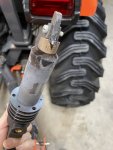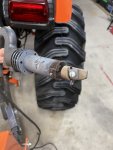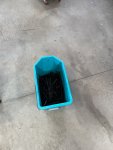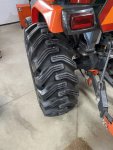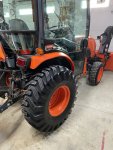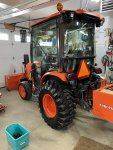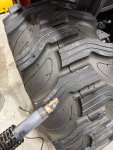Saw that before and didn’t like “to the edge of lug” as I was concerned about tear out. It would be interesting to see them after several years of use.Here's an interesting pattern for your grooves.
Does tire grooving really work?
- Thread starter dfixit1
- Start date
Might wanna consult a few NASCAR engineers and F1 racing engineers about "more surface area" versus "water/mud channeling" NASCAR tires have no tread for a reason, and the lack of any tread is exactly why they shut down a race if 3 drops of rain hit the track. The reason for no tread is traction on pavement at high speed, and is usually maximized by using the largest possible surface area and using a very soft rubber for maximum grip. This is why they try not to spin their tires or drift the car too much out of turns, because to do so makes the soft rubber melt and become slippery on the pavement. It's a fine line between soft and fast or soft and poor durability. They have a limited number of tires to use in a race, and every one's tire is the same size and width. The only flexibility they have is the compounding and brand. Same reasoning for F1 racing, but F1 racing doesn't stop for rain because they change to treaded tires in the rain, but they DO slow down (some). Hydroplaning in a car that will quickly turn into an airplane is a really bad idea. On dry pavement, they run slicks just like NASCAR, and have far more flexibility on size, width, brand, and compounding than does NASCAR. So, if you want maximum surface area, you want slicks. If you want best grip at low speed, then you need bars and lugs. A narrow slit in a tire intended to operate in soft dirt/mud is gonna just fill up with that soft material at low RPM and then do NOTHING for traction. The bar, that is angled to push the loose stuff out the side of the foot print of the tire doesn't have to move fast to do that. A narrow groove is generally helpful for preventing hydroplaning by channeling water out from under a tire on pavement at high speed where the hydraulic forces are a lot higher. It isn't going to do much in mud.
In loose material a slick does NOT offer the most "surface area", the more bars, bumps and ridges, the more surface area. It's just math.Might wanna consult a few NASCAR engineers and F1 racing engineers about "more surface area" versus "water/mud channeling" NASCAR tires have no tread for a reason, and the lack of any tread is exactly why they shut down a race if 3 drops of rain hit the track. The reason for no tread is traction on pavement at high speed, and is usually maximized by using the largest possible surface area and using a very soft rubber for maximum grip. This is why they try not to spin their tires or drift the car too much out of turns, because to do so makes the soft rubber melt and become slippery on the pavement. It's a fine line between soft and fast or soft and poor durability. They have a limited number of tires to use in a race, and every one's tire is the same size and width. The only flexibility they have is the compounding and brand. Same reasoning for F1 racing, but F1 racing doesn't stop for rain because they change to treaded tires in the rain, but they DO slow down (some). Hydroplaning in a car that will quickly turn into an airplane is a really bad idea. On dry pavement, they run slicks just like NASCAR, and have far more flexibility on size, width, brand, and compounding than does NASCAR. So, if you want maximum surface area, you want slicks. If you want best grip at low speed, then you need bars and lugs. A narrow slit in a tire intended to operate in soft dirt/mud is gonna just fill up with that soft material at low RPM and then do NOTHING for traction. The bar, that is angled to push the loose stuff out the side of the foot print of the tire doesn't have to move fast to do that. A narrow groove is generally helpful for preventing hydroplaning by channeling water out from under a tire on pavement at high speed where the hydraulic forces are a lot higher. It isn't going to do much in mud.
Until those bars bumps and ridges fill up with sticky loose material. Then, it turns into a slick. If you have sandy relatively dry loose material, yep, it'll bite pretty good, because that stuff will come back off the tire. Wet clay, nope, all ya gonna do is fill up the little grooves first, then fill up the bar lugs. The rubber in AG tires is relatively hard compared to on-road tires to withstand spinning on rocks, roots, and other things that would otherwise destroy most on-road tires. They also don't go as fast, therefore, won't get hot and wear as fast.In loose material a slick does NOT offer the most "surface area", the more bars, bumps and ridges, the more surface area. It's just math.
You'll find that your calculation is right if the tire is sitting still or just coasting across soft/loose material, but that really isn't providing any traction then, either is it? Once the tire starts spinning, the top and leading edge of the bar are all that are in contact with anything that resembles traction. That's why you see the voids on the trailing edge of the bars. A lot less surface area, in other words. The back side of that bar doesn't help. But, because of the angle, it can strip away layers like a cheese grater to keep a newer and hopefully more suitable surface there for the next bar to grab on. Still, though, less surface area in contact on the moving tire. A slick doesn't care. Spinning, or not, on any surface, it has the same footprint within a very small variance. Well, until you spin it fast to make it more narrow. That ain't gonna happen on a tractor.
I've never said a slick offered better traction other than at high speeds on clean asphalt, and then, only because it's usually a very soft rubber compound designed for high speeds. I just said that it has a larger usable surface area for like sized diameters. The only tractor slicks would be useful on would be a top fuel drag tractor. I don't think I wanna drive that.
Obviously no point in in this discussion. This is simple math. On loose material more tread, more depth, more lugs = MORE SURFACE AREA. Spin it any way you want. Google "Snow Tire Designs" and google "Mud Tire Designs" and finally google "Tractor Tire Designs". You will find a lot of discussion about contact patches, surface areas etc.Until those bars bumps and ridges fill up with sticky loose material. Then, it turns into a slick. If you have sandy relatively dry loose material, yep, it'll bite pretty good, because that stuff will come back off the tire. Wet clay, nope, all ya gonna do is fill up the little grooves first, then fill up the bar lugs. The rubber in AG tires is relatively hard compared to on-road tires to withstand spinning on rocks, roots, and other things that would otherwise destroy most on-road tires. They also don't go as fast, therefore, won't get hot and wear as fast.
You'll find that your calculation is right if the tire is sitting still or just coasting across soft/loose material, but that really isn't providing any traction then, either is it? Once the tire starts spinning, the top and leading edge of the bar are all that are in contact with anything that resembles traction. That's why you see the voids on the trailing edge of the bars. A lot less surface area, in other words. The back side of that bar doesn't help. But, because of the angle, it can strip away layers like a cheese grater to keep a newer and hopefully more suitable surface there for the next bar to grab on. Still, though, less surface area in contact on the moving tire. A slick doesn't care. Spinning, or not, on any surface, it has the same footprint within a very small variance. Well, until you spin it fast to make it more narrow. That ain't gonna happen on a tractor.
I've never said a slick offered better traction other than at high speeds on clean asphalt, and then, only because it's usually a very soft rubber compound designed for high speeds. I just said that it has a larger usable surface area for like sized diameters. The only tractor slicks would be useful on would be a top fuel drag tractor. I don't think I wanna drive that.
Or for a real barnyard example, run your tape measure around each and make sure to follow the contour all the way around. Multiply that by the width and you will have your surface area. The tire with the contour will have a lot more surface area.
I grooved my rear tires with two grooves per lug. Best investment buying the grooving tool. Can blow snow and tractor works even in 2wd. Thought I had in 4wd and when lifted front wheels off ground they were not turning- still in 2wd and still going forward. Best investment purchasing grooving tool.
Oh figured how to attach photos. Here they are. Grooving tool, tires done and bucket of rubber from grooving tires. 
pokey1416
Well-known member
Lifetime Member
Equipment
Grand L4060HSTC, BH92 Backhoe, HLA Snow Pusher, Dirt Dog Tiller, EA DiscHarrow
Your photos didn’t attach.Oh figured how to attach photos. Here they are. Grooving tool, tires done and bucket of rubber from grooving tires.
Oh figured how to attach photos. Here they are. Grooving tool, tires done and bucket of rubber from grooving tires.
Attachments
-
347.4 KB Views: 676
-
335.4 KB Views: 701
-
608.4 KB Views: 685
-
460.8 KB Views: 687
-
475 KB Views: 667
-
568.3 KB Views: 673
-
588.4 KB Views: 633
pokey1416
Well-known member
Lifetime Member
Equipment
Grand L4060HSTC, BH92 Backhoe, HLA Snow Pusher, Dirt Dog Tiller, EA DiscHarrow
Looks very good did you use a template? I’m thinking of single grooving my rears to save some effort. Our winter so far has been a bust so I’m going to do it in warmer weather.
Thanks for pics.
Thanks for pics.
cmorningstar01
Active member
Equipment
B7500HST LA302 FEL 5'Finish Mower B5100E 46" Snow Plow 22 ton splitter
Grooving: V groove versus Parallel groove.
A V groove will expel material from the groove better than a groove with Parallel sides, The square or rounded bottom parallel groove looks nicer but the V groove works better when it comes to expelling material from the groove, If you look at most ag tires you will see that the tread has a greater taper than say R4 tires which helps them bite but also helps them stay clean of caked in mud and clay.
Just something to keep in mind when deciding which cutting blade to use when you groove your tires.
I realize that most tire grooving blades have at least some taper to them but the greater the taper the better for release of ground material from the groove
A V groove will expel material from the groove better than a groove with Parallel sides, The square or rounded bottom parallel groove looks nicer but the V groove works better when it comes to expelling material from the groove, If you look at most ag tires you will see that the tread has a greater taper than say R4 tires which helps them bite but also helps them stay clean of caked in mud and clay.
Just something to keep in mind when deciding which cutting blade to use when you groove your tires.
I realize that most tire grooving blades have at least some taper to them but the greater the taper the better for release of ground material from the groove
Tried a template but was a pain. I just freehanded it.Looks very good did you use a template? I’m thinking of single grooving my rears to save some effort. Our winter so far has been a bust so I’m going to do it in warmer weather.
Thanks for pics.
pokey1416
Well-known member
Lifetime Member
Equipment
Grand L4060HSTC, BH92 Backhoe, HLA Snow Pusher, Dirt Dog Tiller, EA DiscHarrow
I bit the bullet and picked up the VanAlstine V100. Used #6 blades on rears and #4 on fronts. Set to about 1/4” depth. Figured I’d try it this winter and add grooves if needed. Set the groover on 2hi. Blades lasted 15-24 lugs before changing.


pokey1416
Well-known member
Lifetime Member
Equipment
Grand L4060HSTC, BH92 Backhoe, HLA Snow Pusher, Dirt Dog Tiller, EA DiscHarrow
Maybe I should have used a higher setting? This is what a “just about to go” blade and it’s groove look like.I used one blade for all 4 tires and it's still fine! See post #53.
Here’s a fresh blade groove.
I used the Ideal Tire Groover. No setting for how hot it gets, one size fits all! The grooves are 3/16" to 1/4" wide and about the same depth.
Here's some picture of the pattern left in various surfaces.
Here's some picture of the pattern left in various surfaces.
Attachments
-
915.4 KB Views: 427
-
821 KB Views: 428
You do not have to cut R4's deep to realize a SUBSTANTIAL improvement. I grooved mine about 1/8" depth.Siping is great on small flexible lugs. I do not think they would work well on R4's due to how stiff the lugs are. You would have to cut awfully deep to get them to flex enough for the siping to work.
I have a L5740 with filled rear tires, max rear wheel weights, plow / or blower on the front and typically a heavy implement on the back when moving snow. I had questioned grooving / siping the tires for awhile but was considering it and had even ordered the tire groover off of amazon... I had the tool sitting in my shop.
Finally the other night on a particularly icy hilly driveway, after sliding off of the driveway 3 times, I pulled the tractor into my shop and spent about 45 minutes grooving all 4 tires. Went back out on the same driveway, which at this point was later in the evening and even icier. It was a NIGHT and DAY difference. The tractor crawled up the icy hill with ease and quit sliding sideways on the cross sloped portions of the driveway. I was amazed at the difference.
I can firmly attest at the improvement of grooving the R4s. I can now plow uphill without having to get a high speed running start. $100 on Amazon for a groover, 45 minutes of time for huge improvement... and then you can sell it to a friend after you do your own tractor!
Attachments
-
485.7 KB Views: 157
I grooved my R4s and it hasn't snowed since*!!!!
*(While I was up in the mountains at the same time....)
*(While I was up in the mountains at the same time....)
That is/was my experience too, on two different machines. I've lent the tool to a few friends and they also were surprised at the positive difference it makes.You do not have to cut R4's deep to realize a SUBSTANTIAL improvement. I grooved mine about 1/8" depth.
I have a L5740 with filled rear tires, max rear wheel weights, plow / or blower on the front and typically a heavy implement on the back when moving snow. I had questioned grooving / siping the tires for awhile but was considering it and had even ordered the tire groover off of amazon... I had the tool sitting in my shop.
Finally the other night on a particularly icy hilly driveway, after sliding off of the driveway 3 times, I pulled the tractor into my shop and spent about 45 minutes grooving all 4 tires. Went back out on the same driveway, which at this point was later in the evening and even icier. It was a NIGHT and DAY difference. The tractor crawled up the icy hill with ease and quit sliding sideways on the cross sloped portions of the driveway. I was amazed at the difference.
I can firmly attest at the improvement of grooving the R4s. I can now plow uphill without having to get a high speed running start. $100 on Amazon for a groover, 45 minutes of time for huge improvement... and then you can sell it to a friend after you do your own tractor!
Don't you just love all the FB and forum keyboard warriors they sweat it's a stupid thing to do, but have never tried it?
I think it's made a big difference to my MX over the winter as well. Thanks again to @pokey1416 for loaning me his groover.That is/was my experience too, on two different machines. I've lent the tool to a few friends and they also were surprised at the positive difference it makes.
Don't you just love all the FB and forum keyboard warriors they sweat it's a stupid thing to do, but have never tried it?


